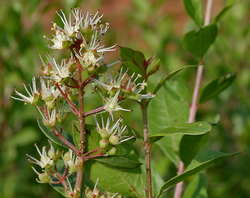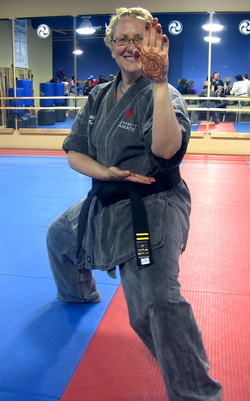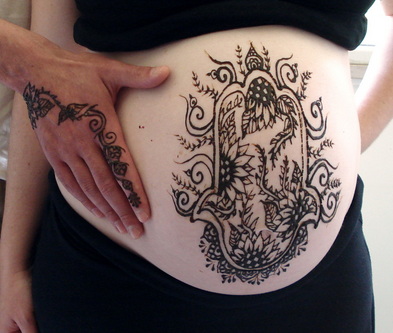An Introduction to Henna
Henna is a natural dye produced from the leaves of the henna plant, a small flowering shrub (scientific name: Lawsonia inermis). The henna plant grows all over the world in hot, dry areas, from North Africa across the Middle East and throughout Southern Asia. It has been used to create beautiful, temporary body art in cultures around the world for thousands of years.
Henna can refer to both the plant itself and the art of applying henna. The word henna (along with variations like French henné and Modern Hebrew חינה, hina) comes from the Arabic word for the plant, al-hinna. In India, Pakistan and other parts of Southeast Asia, henna is often called mehndi (also spelt mehendi).
The leaves contain a dye molecule, lawsone, that stains skin and other organic material (wool, leather, nails, hair, etc.). The leaves are dried and crushed into a powder, which is mixed with a liquid (usually water or lemon juice) to form a thick paste. Sometimes a few drops of an essential oil (such as Tea Tree, Cajeput, or Lavender) are added to aid the flow and help the dye molecules bind with the skin. The resulting colour can vary between a light brown to a dark chocolate or reddish-brown colour, depending on the skin type, body part, and other variables.
Henna can refer to both the plant itself and the art of applying henna. The word henna (along with variations like French henné and Modern Hebrew חינה, hina) comes from the Arabic word for the plant, al-hinna. In India, Pakistan and other parts of Southeast Asia, henna is often called mehndi (also spelt mehendi).
The leaves contain a dye molecule, lawsone, that stains skin and other organic material (wool, leather, nails, hair, etc.). The leaves are dried and crushed into a powder, which is mixed with a liquid (usually water or lemon juice) to form a thick paste. Sometimes a few drops of an essential oil (such as Tea Tree, Cajeput, or Lavender) are added to aid the flow and help the dye molecules bind with the skin. The resulting colour can vary between a light brown to a dark chocolate or reddish-brown colour, depending on the skin type, body part, and other variables.
|
The Song of Songs mentions the henna shrub several times, using the Biblical Hebrew word כפר (kopher).
For example, in the Song of Songs 1:14, we read: אשׁכל הכפר דודי לי בכרמי עין גדי (My beloved is to me like a cluster of henna [blossoms] in the vineyards of 'Ein-Gedi). This is thought to refer to the henna flowers; they are extremely fragrant, are used in perfumes, and are said to have been the Prophet Muhammed's favourite scent. Check out the various pages on the history of henna to learn more! |
Do not use ‘Black Henna’
Often, people ask about 'black henna' - the short answer is that there is no such thing, and that products called black henna usually contain PPD (a dangerous industrial chemical) and can give you blisters, scars, and lasting chemical sensitivities. NEVER get 'black henna'; if you are unsure, ask the artist what's it in. If they can't tell you or say something other than "100% natural henna", walk away.
Please see my section of Frequently Asked Questions for more information.
Often, people ask about 'black henna' - the short answer is that there is no such thing, and that products called black henna usually contain PPD (a dangerous industrial chemical) and can give you blisters, scars, and lasting chemical sensitivities. NEVER get 'black henna'; if you are unsure, ask the artist what's it in. If they can't tell you or say something other than "100% natural henna", walk away.
Please see my section of Frequently Asked Questions for more information.
The Uses of Henna
Henna has many different connotations and symbolism, as varied as the cultures it has been used in. Henna is often connected to weddings and celebrations of love (as seen above in the Song of Songs). Weddings in henna-using cultures are often preceded by a special night where the bride is decorated with henna in the presence of the women from her old and new families. Sometimes the groom has a separate henna ceremony as well. These ceremonies are traditionally practiced across North Africa, the Middle East, and Asia, and are celebrated by the many religions present in those areas: Jews, Christians, Muslims, Hindus, Baha'is, Zoroastrians, and others. However, henna use is not sacred or intrinsic to any religion, and often predates particular religious use in many places.
Henna is also used in many cultures to celebrate festivals and holidays. In Hindu areas, henna is applied for Divali and Karva Chauth as well as other festive occasions. Many Muslims apply henna for Eid and Mawlid, and there are Jewish customs to apply henna for Purim (to emulate Queen Esther, who beautified herself for King Ahashverosh) as well as Passover. Nowrūz, the Persian New Year, is also traditionally celebrated with henna.
Henna can be applied for any festive occasion. Births, circumcisions, victories, birthdays, coming-of-age rituals and other passage ceremonies have traditionally used henna as part of the festivities. Don't feel limited by the traditional uses of henna - it is an evolving art and there is always room to invent new traditions! If you feel that henna would enhance your celebration, go for it!
Click on the gallery link to see pictures of my henna art, learn more about the history of henna or Jewish henna traditions, or read some of my Frequently Asked Questions.
Also, feel free to contact me with any questions or requests.
Henna is also used in many cultures to celebrate festivals and holidays. In Hindu areas, henna is applied for Divali and Karva Chauth as well as other festive occasions. Many Muslims apply henna for Eid and Mawlid, and there are Jewish customs to apply henna for Purim (to emulate Queen Esther, who beautified herself for King Ahashverosh) as well as Passover. Nowrūz, the Persian New Year, is also traditionally celebrated with henna.
Henna can be applied for any festive occasion. Births, circumcisions, victories, birthdays, coming-of-age rituals and other passage ceremonies have traditionally used henna as part of the festivities. Don't feel limited by the traditional uses of henna - it is an evolving art and there is always room to invent new traditions! If you feel that henna would enhance your celebration, go for it!
Click on the gallery link to see pictures of my henna art, learn more about the history of henna or Jewish henna traditions, or read some of my Frequently Asked Questions.
Also, feel free to contact me with any questions or requests.


